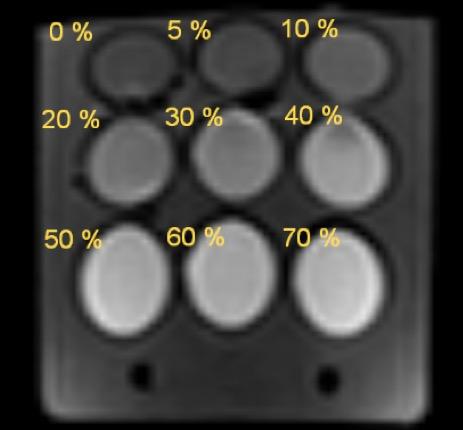An MRI technique has been developed to improve the detection of tumors

DWI of the phantom with polyvinylpyrrolidone (PVP) solutions (b value 500 s/mm2). Credit: Kristina Sergunova et al.
The way the H2O molecules move depends on whether they are inside or outside the cells. Inside the cell the water movement is somewhat restricted by organelles that sometimes get in the way (slow diffusion) and semi-permeable cell membranes (hindered diffusion).
Since in-between the cells there is more room, the only thing that restrict the water movement is cell membrane.
Such movement can be estimated through the mathematical processing of DWI data using apparent diffusion coefficient (ADC) maps. In absence of pathological tissues the intracellular ADC is lower compared to intercellular ADC.
However, an increase in cell density (in presence of malignancies, especially those made up of many small-size cells) leads to a decrease in intercellular diffusion.
Since ACD is not an absolute value, it makes it dependable on external factors, such as sequence and reconstruction parameters, image quality and hardware features. In order to boost the efficacy of tumor differential diagnostics ACD must be estimated with greater accuracy and reproducibility.
This can be achieved with phantoms (also called test objects) that allow assessing the imaging quality and building various diffusion models (i.e. non-restricted, hindered, and restricted diffusion with permiable and semi-permiable membranes).
Such phantom has been developed by a research team from the Innovation Technology Department of the Moscow Center for Diagnostics & Telemedicine.
The scope of application of the phantoms developed by the US National Institute of Standards and Technology, the Quantitative Imaging Biomarkers Alliance and the Institute of Cancer Research in the UK is limited because they utilize polymer solutions.
Instead, the authors of this paper suggested using a combination of siloxane-based water-in-oil (W/O) emulsions and aqueous solutions of polyvinylpyrrolidone (PVP). This components allow emulating both hindered and restricted diffusion while maintaining relatively high signal intensity.
What is more, the newly-designed phantom can be used to assess the image quality control in terms of fat suppression, which again is critical for detecting pathological processes.
To simulate hindered diffusion, the investigators used aqueous PVP solutions with concentrations of 0 to 70%. The W/O emulsions imitated restricted diffusion in intracellular space. To attain high DWI signal (maximum radiolucent areas), the authors incorporated silicone oil: cyclomethicone and caprylyl-methicone. This phantom was scanned using 1.5T magnetic resonance scanner with various fat suppression techniques.
After a series of control experiments the authors came to a conclusion, that such phantom with the control substances allows modelling the apparent diffusion coefficients ranging from normal tissue to benign and malignant lesions: from 2.29 to 0.28mm2/s. Correspondingly, it is suitable for assessing the ACD measurement quality and the efficacy of fat suppression, as well as for calibrating MR scanners from varioous manufacturers.
This study is a part of the bigger research project started in the Moscow Center for Diagnostics & Telemedicine in 2017, that addresses standardization and optimization of MR scanners. The project is also aimed at developing the means of control over the scanner parameters to secure the high image quality and increase the diagnostic value of imaging studies.
Media Contact
All latest news from the category: Medical Engineering
The development of medical equipment, products and technical procedures is characterized by high research and development costs in a variety of fields related to the study of human medicine.
innovations-report provides informative and stimulating reports and articles on topics ranging from imaging processes, cell and tissue techniques, optical techniques, implants, orthopedic aids, clinical and medical office equipment, dialysis systems and x-ray/radiation monitoring devices to endoscopy, ultrasound, surgical techniques, and dental materials.
Newest articles

Parallel Paths: Understanding Malaria Resistance in Chimpanzees and Humans
The closest relatives of humans adapt genetically to habitats and infections Survival of the Fittest: Genetic Adaptations Uncovered in Chimpanzees Görlitz, 10.01.2025. Chimpanzees have genetic adaptations that help them survive…

You are What You Eat—Stanford Study Links Fiber to Anti-Cancer Gene Modulation
The Fiber Gap: A Growing Concern in American Diets Fiber is well known to be an important part of a healthy diet, yet less than 10% of Americans eat the minimum recommended…

Trust Your Gut—RNA-Protein Discovery for Better Immunity
HIRI researchers uncover control mechanisms of polysaccharide utilization in Bacteroides thetaiotaomicron. Researchers at the Helmholtz Institute for RNA-based Infection Research (HIRI) and the Julius-Maximilians-Universität (JMU) in Würzburg have identified a…



